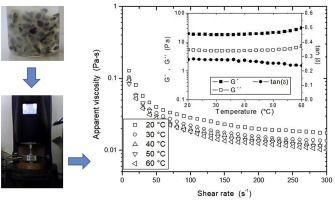当前位置:
X-MOL 学术
›
Food Hydrocoll.
›
论文详情
Our official English website, www.x-mol.net, welcomes your
feedback! (Note: you will need to create a separate account there.)
Effect of concentration, temperature, pH, co-solutes on the rheological properties of Hyptis suaveolens L. mucilage dispersions
Food Hydrocolloids ( IF 11.0 ) Pub Date : 2019-02-01 , DOI: 10.1016/j.foodhyd.2018.08.004 Juan Pablo Pérez-Orozco , Leticia Mónica Sánchez-Herrera , Rosa Isela Ortiz-Basurto
Food Hydrocolloids ( IF 11.0 ) Pub Date : 2019-02-01 , DOI: 10.1016/j.foodhyd.2018.08.004 Juan Pablo Pérez-Orozco , Leticia Mónica Sánchez-Herrera , Rosa Isela Ortiz-Basurto

|
Abstract The rheological behavior of mucilage dispersions obtained from Hyptis suaveolens L. seeds was characterized. The apparent viscosity showed a non-Newtonian shear-thinning behavior in a range of shear rate 0.1–300 s−1 at 25 °C and pH 6.5. The Cross and Herschel-Bulkley parameters (r2 > 0.9923) indicated that more physical entanglements arise with increasing concentration (0.1–0.75% w/v). Mechanical spectra were obtained by frequency sweep measurement (0.01–10 Hz) at 0.1% deformation and 25 °C. A G´-G´´ cross-over point was observed (1 Hz) for a 0.1% mucilage dispersion, suggesting a molecular transition from random coil to an entangled conformation. The tan(δ) performance for mucilage dispersion with 0.25–0.75% (w/v) concentrations, with values between 0.2 and 0.3, classified into an intermediate behavior between weak and elastic gel. The G´ values were well characterized by power-law frequency dependence ( r 2 ≥ 0.9628 ) . The mucilage dispersion exhibited temperature stability between 20 and 60 °C, and activation energies with values between 7.20 and 12.85 kJmol-1 indicated that more energy was required to disrupt the formed entanglements and to induce viscous flow. For 0.5% mucilage dispersion, the NaCl addition (0–250 mM) generate more aggregates which disruption became more shear dependence as salt concentration growth, and the formed entanglements were less flexible from neutral to alkaline conditions. The sucrose addition (1, 3, 5, 10, and 20% w/v) into 0.5% mucilage dispersion produced a less shear-thinning behavior, giving a stabilizing effect and enhancing the biopolymer gel strength. These results suggest that mucilage could be applied in many food applications, such as stabilizing, thickening and gelling agents.
中文翻译:

浓度、温度、pH 值、共溶质对 Hyptis suaveolens L. 粘液分散体流变特性的影响
摘要 表征了从 Hyptis suaveolens L. 种子中获得的粘液分散体的流变行为。表观粘度在 25 °C 和 pH 6.5 的剪切速率 0.1–300 s-1 范围内显示出非牛顿剪切稀化行为。Cross 和 Herschel-Bulkley 参数 (r2 > 0.9923) 表明随着浓度的增加 (0.1–0.75% w/v),更多的物理纠缠出现。通过频率扫描测量 (0.01–10 Hz) 在 0.1% 变形和 25°C 下获得机械谱。对于 0.1% 的粘液分散,观察到 AG´-G´´ 交叉点 (1 Hz),表明分子从无规卷曲到缠结构象的转变。0.25-0.75% (w/v) 浓度的粘液分散体的 tan(δ) 性能,值在 0.2 和 0.3 之间,归类为介于弱凝胶和弹性凝胶之间的中间行为。G´ 值由幂律频率相关性很好地表征(r 2 ≥ 0.9628)。粘液分散体在 20 到 60 °C 之间表现出温度稳定性,活化能在 7.20 到 12.85 kJmol-1 之间表明需要更多的能量来破坏形成的缠结并诱导粘性流动。对于 0.5% 的粘液分散体,添加 NaCl (0-250 mM) 会产生更多的聚集体,随着盐浓度的增长,这些聚集体变得更加依赖剪切,并且形成的缠结在从中性到碱性条件下的灵活性较低。将蔗糖(1、3、5、10 和 20% w/v)添加到 0.5% 的粘液分散体中会产生较少的剪切稀化行为,从而产生稳定效果并增强生物聚合物凝胶强度。这些结果表明粘液可以应用于许多食品应用中,
更新日期:2019-02-01
中文翻译:

浓度、温度、pH 值、共溶质对 Hyptis suaveolens L. 粘液分散体流变特性的影响
摘要 表征了从 Hyptis suaveolens L. 种子中获得的粘液分散体的流变行为。表观粘度在 25 °C 和 pH 6.5 的剪切速率 0.1–300 s-1 范围内显示出非牛顿剪切稀化行为。Cross 和 Herschel-Bulkley 参数 (r2 > 0.9923) 表明随着浓度的增加 (0.1–0.75% w/v),更多的物理纠缠出现。通过频率扫描测量 (0.01–10 Hz) 在 0.1% 变形和 25°C 下获得机械谱。对于 0.1% 的粘液分散,观察到 AG´-G´´ 交叉点 (1 Hz),表明分子从无规卷曲到缠结构象的转变。0.25-0.75% (w/v) 浓度的粘液分散体的 tan(δ) 性能,值在 0.2 和 0.3 之间,归类为介于弱凝胶和弹性凝胶之间的中间行为。G´ 值由幂律频率相关性很好地表征(r 2 ≥ 0.9628)。粘液分散体在 20 到 60 °C 之间表现出温度稳定性,活化能在 7.20 到 12.85 kJmol-1 之间表明需要更多的能量来破坏形成的缠结并诱导粘性流动。对于 0.5% 的粘液分散体,添加 NaCl (0-250 mM) 会产生更多的聚集体,随着盐浓度的增长,这些聚集体变得更加依赖剪切,并且形成的缠结在从中性到碱性条件下的灵活性较低。将蔗糖(1、3、5、10 和 20% w/v)添加到 0.5% 的粘液分散体中会产生较少的剪切稀化行为,从而产生稳定效果并增强生物聚合物凝胶强度。这些结果表明粘液可以应用于许多食品应用中,











































 京公网安备 11010802027423号
京公网安备 11010802027423号